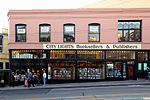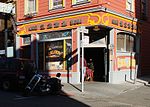Big Al's
Landmarks in San FranciscoNorth Beach, San FranciscoSex industry in San Francisco

Big Al's was one of the first topless bars in San Francisco and the United States since the mid-1960s. It was the first bottomless bar in San Francisco. It is next to the Condor Club, where the strip-club phenomenon began; and as of 1991, claimed to be one of the largest porn stores in San Francisco.The adult book store closed its doors in 2009. It was later replaced by a sandwich store, and is currently a cigar shop. Both businesses kept the venue's name and iconic neon sign. A San Francisco landmark, the site has been featured in several films and TV shows, on postcards, and in tourist brochures.
Excerpt from the Wikipedia article Big Al's (License: CC BY-SA 3.0, Authors, Images).Big Al's
Columbus Avenue, San Francisco
Geographical coordinates (GPS) Address Nearby Places Show on map
Geographical coordinates (GPS)
| Latitude | Longitude |
|---|---|
| N 37.798 ° | E -122.4066 ° |
Address
Europa hotel
Columbus Avenue 320
94133 San Francisco
California, United States
Open on Google Maps










